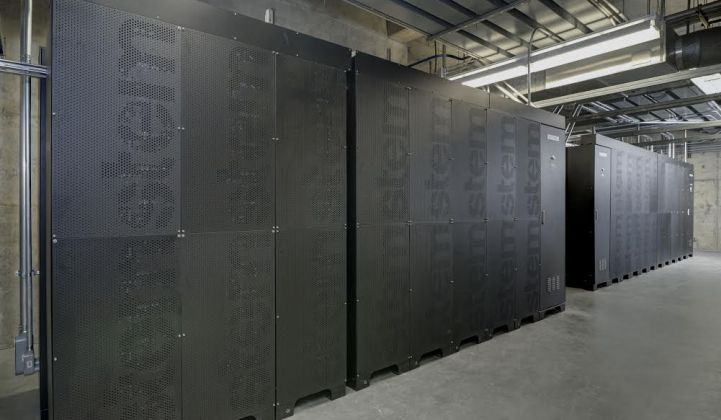Behind-the-meter batteries and demand response can add up to more than the sum of their parts, according to CPower and Stem.
On Tuesday, the demand response provider and the behind-the-meter battery startup announced they’re combining their technologies into an “integrated solution for managing electricity demand” for commercial, industrial and institutional customers, starting in California.
The new partnership is based on a simple set of premises. Batteries are fast and reliable energy resources for buildings looking to reduce demand charges or offer grid services, but expensive compared to the technology to control building HVAC systems, refrigerators, factory production equipment, and other energy-intensive loads. But these load control systems, while relatively cheap, are less flexible and fast-reacting than batteries, and limited by the fact that sometimes they simply can’t be turned off.
Combining the two in an integrated package, however, can harness the better qualities of each resource, and allow customers to tap a broader range of cost-reduction and revenue-generating capabilities, according to Jason Babik, CPower’s senior VP of business strategy and development.
“If you're solving it all with a battery, it’s going to be an expensive solution. If you’re doing it all with curtailment, it’s going to be a potentially disruptive solution,” he said in an interview. But combining the two “can be really a 'one plus one equals three' type play, because you have a more dynamic resilient response to an event or a need.”
“We’re in the early days of the partnership, but our vision is that you can be switching between curtailment and batteries in a way that’s transparent to the customers -- they’re not noticing that both are happening in an automated fashion,” he said.
It’s not the first time we’ve seen batteries integrated with building energy controls. Tesla and EnerNOC have combined them in pilot projects in California supermarkets, and Advanced Microgrid Solutions and PowerSecure are integrating energy storage and building backup power systems. Industrial energy controls provider Powerit Solutions has been combining lower-cost load controls and efficiently sized batteries for years now.
But CPower and Stem say the new partnership is among the first to move beyond one-off projects, and toward a more standardized offering that could make financial sense to a broader range of customers. “We’re taking the best of both of our capabilities, and doing what each of us does well, in a more elegant, cohesive solution,” said Babik.
While the companies haven’t named any customers yet, “We are engaging with customers already, and we’re looking forward to some quick wins in California,” he added. That could include some of the customers that CPower will be signing up for the 35-megawatt bid it won to provide capacity for the state’s Demand Response Auction Mechanism (DRAM) program, the distributed energy resource pilot program that Stem is also participating in.
“We did get a pretty nice DRAM contract, and certainly that is an option,” said Babik. “But we’re not limiting it to that specifically. It can be multiple...programs and multiple regions, as well as programs in New England and New York.”
CPower has a lot of customers to tap for the new offering -- it manages about 3,100 megawatts of demand response resource for more than 1,500 customers at about 7,000 sites across the country, including those it got from its acquisitions of Demand Response Partners and Johnson Control’s EnergyConnect platform.
Stem has deployed more than 120 megawatt-hours of its lithium-ion battery systems at buildings in California, Hawaii and Texas, and is in the midst of signing up customers to fulfill its contract to deliver 85 megawatts of capacity by 2020 to utility Southern California Edison. The company now has 700 sites in its portfolio that are in some stage of development or being interconnected, said Karen Butterfield, Stem’s chief commercial officer, said in an interview.
“It’s our customers who drove us into this use case,” said Butterfield. “They called us and said, ‘We have a Stem system on site, and you’re charging and discharging the battery to manage demand charges. But we’re also enrolling in a demand response program. Can we combine the capacity with the demand response capability and increase our ability to earn in an existing program?’"
“Like any use case, we started working on it in a manual way, and then we started to automate it, and started talking to demand response companies," said Butterfield.
“We have customers who are currently getting paid in a DR program that CPower manages for them,” offering the two companies a ready-made setting for testing the value of their combined technologies, she added.
Of course, not all customers will have the right combination of curtailable loads, time-of-use electricity pricing, demand charge costs, or ability to participate in demand response programs to allow a combo battery-load control package to pencil out economically. At the same time, the regulatory structures that could allow C&I customers to participate in energy markets, or serve as replacements for utility grid upgrades, are still under development in most states, including leaders like California and New York.
“We feel we’re a little bit ahead of that curve,” Butterfield said. “We’re looking for the market to catch up and provide those signals, so we’re able to engage customers and bring more value, savings, and earnings potential.”



